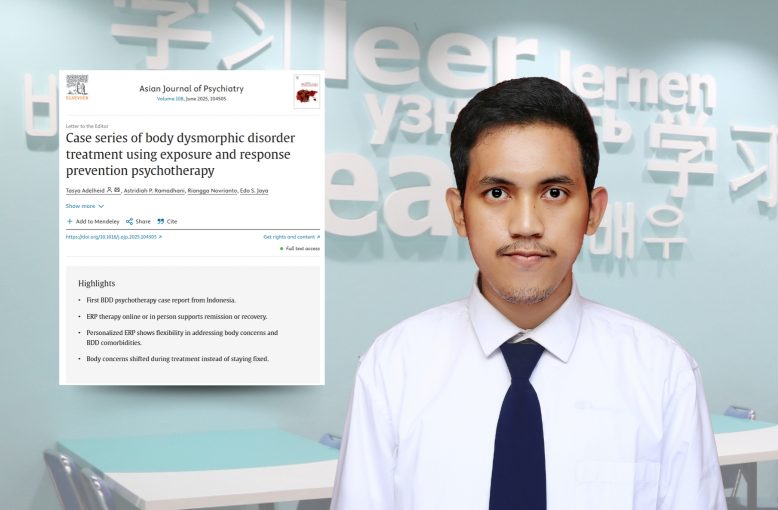
Yogyakarta, May 6, 2025 – A recent study titled “Case series of body dysmorphic disorder treatment using exposure and response prevention psychotherapy”, authored by Tasya Adelheid, Astridiah P. Ramadhani, Riangga Novrianto, and Edo S. Jaya, has been published in the Asian Journal of Psychiatry (Vol. 108, Article No. 104505). This journal is indexed in Scopus, ranked in Quartile Q1, with a Citation Score of 12.7 and an Impact Factor (IF) of 3.8.
The article presents the effectiveness of Exposure and Response Prevention (ERP)-based psychotherapy in treating individuals with Body Dysmorphic Disorder (BDD). BDD is a mental disorder characterized by an excessive preoccupation with perceived physical flaws that are often unnoticeable to others. This condition frequently leads to severe anxiety, social isolation, and a decline in quality of life.
In this case series, the researchers documented the ERP therapy process in several patients diagnosed with BDD. The therapy results demonstrated significant reductions in anxiety levels, compulsive behaviors, and social functioning impairments. ERP — a component of Cognitive Behavioral Therapy (CBT) — proved effective in helping patients confront their fears without engaging in compulsive responses such as excessive mirror checking or seeking reassurance.
Furthermore, Riangga stated that this research not only contributes to clinical practice in the treatment of BDD but also supports Sustainable Development Goal (SDG) 3: Good Health and Well-being, particularly target 3.4, which emphasizes the importance of promoting mental health and reducing non-communicable diseases through appropriate prevention and treatment approaches.
Below is the introduction, keywords, and article link:
Introduction. Body Dysmorphic Disorder (BDD) is characterized by a persistent preoccupation with perceived physical flaws that are often unnoticed by others. It affects approximately 1.9–2.2 % of the population (Veale et al., 2016) and is associated with significant risks, including suicide attempts in 24–28 % of cases (Phillips, 2007). Effective treatment is critical. Exposure and Response Prevention (ERP), a form of Cognitive Behavioral Therapy (CBT), helps patients confront feared stimuli while resisting compulsive behaviors (Hyman and Pedrick, 2010). While randomized trials support CBT’s effectiveness (Wilhelm et al., 2019), research on BDD treatment in Indonesia remains limited despite the disorder’s prevalence and suicide risk.
This study examines three BDD patients receiving weekly online and in-person ERP at a Jakarta psychotherapy office. Patients consented to the anonymized data use for research. Assessments included the Patient Health Questionnaire (PHQ), Body Dysmorphic Disorder Questionnaire (BDDQ), and the Yale-Brown Obsessive-Compulsive Scale Modified for Body Dysmorphic Disorder (BDD-YBOCS) (Jaya et al., 2024; Phillips et al., 1995; Phillips et al., 1997). Progress was tracked through symptom reduction and changes in BDD-YBOCS scores.
Keywords: Body Dysmorphic Disorder; Exposure and Response Prevention Therapy; Cognitive Behavioral Therapy; Case Series
Link: https://www.sciencedirect.com/science/article/pii/S1876201825001480?via%3Dihub
Based on its keywords, this article is a research output aligned with SDG 3.
Congratulations to Mr. Riangga and the author team.
Writer & Editor: UP & Public Relations Team
